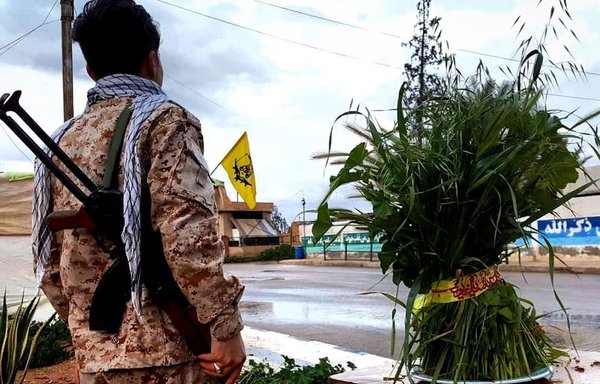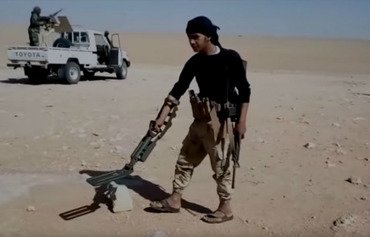In the area to the east of the Syrian city of Palmyra, due north of al-Tanf garrison in the tri-border area, local sources have observed rare co-operation between Russian and Iranian forces and the militias they control.
International coalition and Jaish Maghawir al-Thawra forces are stationed at al-Tanf, near al-Rukban displacement camp on the Syria-Jordan border.
Al-Rukban, an informal camp, is home to civilians who fled the Syrian regime in Deir Ezzor province and the families of Jaish Maghawir al-Thawra militiamen.
Officers of the Russian army, and of Iran's Islamic Revolutionary Guard Corps (IRGC) and the Fatemiyoun Division it controls, were spotted in early November at the T3 station in Homs, the Syrian Observatory for Human Rights said.
![Jaish Maghawir al-Thawra elements conduct a patrol. The militia is in charge of providing security for the Eastern Desert area of southern Syria around al-Tanf base. [Jaish Maghawir al-Thawra]](/cnmi_am/images/2022/12/09/39143-al-tanf-patrol-600_384.jpg)
Jaish Maghawir al-Thawra elements conduct a patrol. The militia is in charge of providing security for the Eastern Desert area of southern Syria around al-Tanf base. [Jaish Maghawir al-Thawra]
![Al-Rukban camp residents are seen here in a photo posted online on June 25. Activists say there are growing concerns that civilians in the camp could be in danger in view of the Iranian and Russian movements. [Al-Rukban camp Facebook page]](/cnmi_am/images/2022/12/09/39144-al-rukban-civilians-600_384.jpg)
Al-Rukban camp residents are seen here in a photo posted online on June 25. Activists say there are growing concerns that civilians in the camp could be in danger in view of the Iranian and Russian movements. [Al-Rukban camp Facebook page]
T3 is due north of al-Tanf base.
The tri-border area where al-Tanf is situated, near crossings with Jordan and Iraq, "is one of the most strategic areas in Syria at the present time", Egyptian military analyst Abdel Karim Ahmed told Al-Mashareq.
International coalition forces have a presence at al-Tanf base and in the 55km-radius deconfliction zone that surrounds it, he said.
"This makes the region a real obstacle that prevents the IRGC and its affiliates from controlling the entire border area, be it the frontier with Jordan or Iraq," he said.
Iran-aligned militias, including Lebanese Hizbullah, seek to use the border with Jordan as a drug-smuggling route, he said, while Iran seeks to control the border with Iraq to further its ambition of establishing a corridor to Beirut.
Bringing in constant reinforcements
The T3 area "is already witnessing constant movements by the IRGC Quds Force and the Afghan Fatemiyoun Division, with constant reinforcements of weapons and personnel being brought in", said media activist Ammar Saleh.
Also noticeable is the presence of Syrian forces, which guard the facilities in the area.
"In addition to the presence of officers and their escorts on the ground, Russian planes fly over the region from time to time, as if to provide security cover for these movements," Saleh told Al-Mashareq.
Saleh said the joint movements by the IRGC and its affiliates -- the Fatemiyoun Division and Lebanese Hizbullah in particular -- and by the Russian army and Syrian regime forces are concentrated in the Palmyra military airport area.
In this area and in Syria's eastern desert (Badiya) "periodic exercises and manoeuvres take place, punctuated by the firing of medium and short-range missiles that can be openly seen from short distances", he said.
These missiles are Iranian made and are fired at fixed targets in the Syrian Badiya and the Palmyra military airport, the Observatory said.
Concern for al-Rukban civilians
"The concerns are related not only to security and the military situation but also to the civilians in al-Rukban camp, as there are fears that the siege imposed on the camp could be tightened to force them to leave it," Saleh said.
This has happened before, he said, "in order to put pressure on international coalition forces and Jaish Maghawir al-Thawra".
Saleh said other concerns are related to the possible resurgence of the "Islamic State of Iraq and Syria" (ISIS), "which would give Russia and Iran an excuse to intervene".
This has been the case in Daraa province, he noted, where ISIS-affiliated groups suddenly reappeared, even though the security situation is "controlled" by Russia and the Syrian regime and their affiliated militias.
ISIS on November 30 announced the death of its leader Abu Hasan al-Hashimi al-Qurashi, who local sources said had blown himself up under siege in Daraa province during an operation carried out by Syrian opposition factions.
Convergence of interests
"The Russian-Iranian military co-operation in al-Tanf border area is not surprising, despite the polarisation and tension that have characterised the relationship between the two sides recently," political researcher Abdul Nabi Bakkar told Al-Mashareq.
"This co-operation stems from a convergence of interests," said Bakkar, a professor at Al-Azhar University's faculty of sharia and law.
He explained that "both Russia and Iran want full control, or at least joint control, and it often will be agreed upon that Russia would control the border area with Jordan and leave the border area with Iraq to the IRGC".
This is especially the case "after the Jordanian-Russian understandings on border security and the ongoing battles in the Daraa region", he said.
"But there is still one thing that impedes this plan, and it is al-Tanf base."
Bakkar said that Iran-aligned forces believe that gaining control of the al-Tanf area would lift the threat of air strikes from the IRGC and its proxies in Syria and facilitate their movements to the utmost extent.
This would spare them "from having to change positions almost daily to avoid being hit by air strikes", he added.








